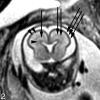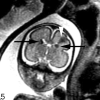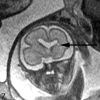Magnetic resonance imaging of the fetal brain and spine: an increasingly important tool in prenatal diagnosis, part 1
- PMID: 16971596
- PMCID: PMC8139801
Magnetic resonance imaging of the fetal brain and spine: an increasingly important tool in prenatal diagnosis, part 1
Abstract
Fetal MR imaging is an increasingly available technique used to evaluate the fetal brain and spine. This is made possible by recent advances in technology, such as rapid pulse sequences, parallel imaging and advances in coil design. This provides a unique opportunity to evaluate processes that cannot be approached by any other current imaging technique and affords a unique opportunity for studying in vivo brain development and early diagnosis of congenital abnormalities inadequately visualized or undetectable by prenatal sonography. This 2-part review summarizes some of the latest developments in MR imaging of the fetal brain and spine and its application to prenatal diagnosis. This first part discusses the utility, safety, and technical aspects of fetal MR imaging, the appearance of normal fetal brain development, and the role of fetal MR imaging in the evaluation of fetal ventriculomegaly. The second part focuses on additional clinical applications of fetal MR imaging, including suspected abnormalities of the corpus callosum, malformations of cortical development, and spine abnormalities.
Figures








References
-
- Raybaud C, Levrier O, Brunel H, et al. MR imaging of fetal brain malformations. Childs Nerv Syst 2003;19:455–70 - PubMed
-
- Coakley FV, Glenn O, Qayyum A, et al. Fetal MRI: A developing technique for the developing patient. AJR Am J Roentgenol 2004;182:243–52 - PubMed
-
- Filly RA, Goldstein RB, Callen PW. Fetal ventricle: importance in routine obstetric sonography. Radiology 1991;181:1–7 - PubMed
-
- Aubry MC, Aubry JP, Dommergues M. Sonographic prenatal diagnosis of central nervous system abnormalities. Childs Nerv Syst 2003;19:391–402 - PubMed
-
- Girard N, Raybaud C, Dercole C, et al. In vivo MRI of the fetal brain. Neuroradiology 1993;35:431–36 - PubMed
Publication types
MeSH terms
Grants and funding
LinkOut - more resources
Full Text Sources
Other Literature Sources
Medical
